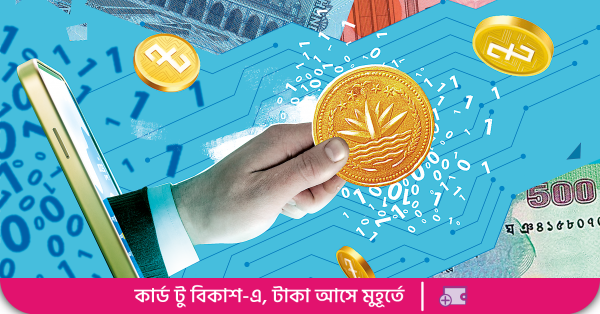
Striking the right note between embracing innovation and ensuring financial inclusion for all will be key to navigating the evolving landscape of money, not only in Bangladesh but also in the rest of the world
If the economy has a soundtrack it most certainly is the satisfying clink of coins and the oddly comforting rustle of bank notes. They have been serving as the lifeblood of transactions for centuries.
But now, the tune is changing into the dings of successful contactless payment notifications.
This begs the critical question: does the rise of digital currency signal the demise of physical money?
While a complete eradication of cash seems improbable, its future, even in Bangladesh, is undoubtedly intertwined with the burgeoning digital landscape.
We have witnessed a remarkable surge in digital payment adoption, fueled by several factors. Firstly, mobile phone penetration in Bangladesh stands at about 90% and around 50% of them own smartphones, making smartphones ubiquitous tools for conducting digital transactions.
Yelding this tool, Mobile financial services (MFS) like bKash, Rocket and others have revolutionised financial inclusion in Bangladesh. These platforms have allowed millions, especially in rural areas, to access financial services previously out of reach. The convenience and security of digital transactions are undeniable, leading to a steady increase in their use.
As of now, approximately 198 million users are registered with 13 MFS providers in Bangladesh, a country with a population of 170 million, as many individuals maintain multiple MFS accounts.
Over the past year or so, bKash has introduced features like biometric ‘Face ID’ and ‘Fingerprint’ login features. Alongside features like ‘ Group Send Money’, ‘Request Money’, and ‘Savings Marketplace’. Making the platform even safer and attractive.
Bangladesh Bank has launched the ‘Cashless Bangladesh Smart Bangladesh’ campaign in 2023, intending to integrate small-scale merchants into an affordable payment system. As part of this initiative, BB offers charge-free transactions through the ‘Bangla QR’ code to micro-merchants for gearing up the cashless Bangladesh programme.
Ten banks, three mobile financial services and three international payment gateways have participated actively in the ‘Bangla QR’ initiative.
Secondly, concerns surrounding hygiene during the global pandemic spurred the preference for contactless payments, further accelerating the shift towards digital alternatives. Additionally, the undeniable convenience and efficiency of digital platforms, particularly for online shopping and bill payments, have further cemented their popularity.
However, a complete transition away from physical currency in Bangladesh is not happening anytime soon.
Despite everything, we love our taka germs and all. Taka remains peerless be it for boldly proclaiming our eternal love or jotting down a quick note. Oh right, payments.
A substantial portion of the population, especially in rural areas, remains unbanked or underbanked, lacking access to essential digital financial services.
Hard cash remains the primary mode of payment for a significant portion of the population, particularly in smaller towns and rural areas.
Furthermore, taka plays a crucial role in informal economies, small businesses, and everyday transactions like buying street food or paying for rickshaw rides.
Digital alternatives haven’t yet permeated these spaces as effectively.
The story of taka is not unique. Globally, physical currency still holds considerable weight. A 2023 report by Smithers estimates that roughly $40 trillion worth of physical money remains in circulation worldwide, despite the rise of digital alternatives.
Furthermore, challenges concerning digital literacy and trust in online transactions persist, particularly among older generations.
Therefore, when analysing the future of taka and physical money in general, it is crucial to acknowledge that both physical and digital forms are likely to co-exist for the foreseeable future.
The Bangladesh Bank has not expressed any intention of eliminating physical currency entirely, indicating a focus on creating a complementary system rather than a complete replacement.
According to Eswar Prasad, a senior fellow at Brookings and author of the book, The Future of Money: How the Digital Revolution Is Transforming Currencies and Finance, “Credit card and cell phone payments have disrupted the physical cash market already,” but Prasad says “the real driving force will be central banks—as new cryptocurrencies continue to emerge and their popularity expands, central banks will react by developing their own more stable forms.”
Bangladesh Bank is actively exploring the potential of Central Bank Digital Currencies (CBDCs). These government-backed digital currencies aim to combine the benefits of digital transactions with the stability and security associated with traditional central bank-issued currencies.
The implementation of CBDCs in Bangladesh is still in its early stages, but it holds the potential to further reshape the financial landscape. It could potentially offer greater financial inclusion, improved efficiency in government payments and enhanced security compared to private cryptocurrencies.
However, concerns and challenges also remain when it comes to CBDCs. Ensuring equitable access to CBDCs, addressing potential financial stability risks, and navigating the regulatory landscape are all crucial issues that need to be addressed.
The rise of digital payment in Bangladesh, while significant, does not necessarily signify the death knell of physical money. Both forms are likely to co-exist, catering to different needs and preferences.
The key lies in creating a dynamic ecosystem that fosters financial inclusion and facilitates seamless transactions, irrespective of the chosen method – cash or digital.
Striking the right note between embracing innovation and ensuring financial inclusion for all will be key to navigating the evolving landscape of money not only in Bangladesh but also in the rest of the world.
